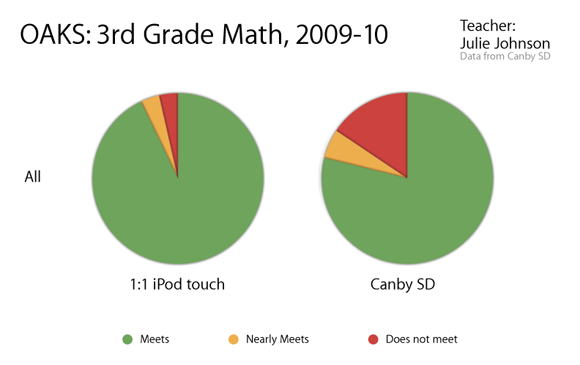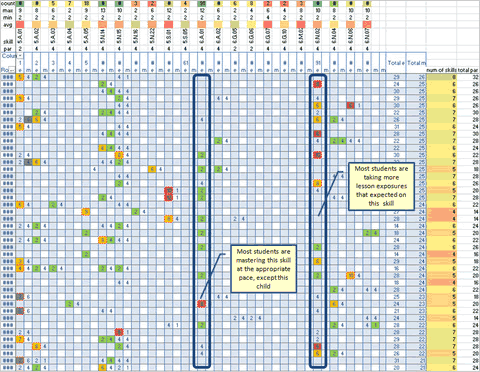Part four: digital classrooms demand a new kind of teacher
In this four-part series, we look at the impact of tablet computing on education: how tablets can save North American students, but how their ability to collect and analyze how students learn will make teaching more accountable — something that unions will oppose aggressively as they try to protect their members’ jobs.
This is a detailed write-up of the Short Bit I first presented at Bitnorth 2010, with lots of background and links to references I found while putting together that presentation. We decided to break it into several parts to make it easier to digest.
Tablet computing is the catalyst that can trigger a classroom revolution: the digital classroom, personalized learning, cheap access to content, and a transformation of how we learn. They promise a shift in education that puts the student, not the teacher, at the center of the learning experience. And tablets can capture and analyze everything about how someone learns.
In other words, tablets make teaching accountable, bringing to it the kind of clarity and can’t-argue-with-that science that has transformed online marketing. But as we saw yesterday, there are powerful forces terrified of what the harsh light of accountability will reveal, as we saw yesterday.
Tablets don’t just display, they collect
 Tablets are the ultimate analytical tool. They collect copious amounts of data that can be analyzed, letting us crunch all aspects of a learning experience: What was read, touched, and heard; when and where that learning happened; what was read slowly and what was rushed through. Properly instrumented, a tablet is a window into how a student acquires knowledge. It’s the perfect sensor for educational analytics.
Tablets are the ultimate analytical tool. They collect copious amounts of data that can be analyzed, letting us crunch all aspects of a learning experience: What was read, touched, and heard; when and where that learning happened; what was read slowly and what was rushed through. Properly instrumented, a tablet is a window into how a student acquires knowledge. It’s the perfect sensor for educational analytics.
And analytics, as anyone who runs a website will tell you, mean accountability. As we saw yesterday, accountability is something that unions have resisted defiantly for decades.
Tablets, and the digital revolution they bring into the classroom, could radically change the way we learn, and with that, the fate of a society. But they’ll be fought every step of the way by teachers who fear for their jobs. If those teachers win, it’ll be another continent’s turn. So convinced of this was the producer of 2 Million Minutes that, when I saw him speak last year, he admitted to buying a condominium in Mumbai for his retirement because he expected India to have the best standard of living.
Worse, since countries like the U.S. and Canada are huge consumers of the world’s resources — and yet some of the strongest opponents to actually fixing crises that have resulted from overpopulation and mass consumption — it may not just be another continent’s turn. It may be another species’. In an era of globalization, overpopulation, and technology, an illiterate North American electorate is bad for the planet’s health. As Snarkmarket says, forget Skynet; the real apocalypse starts when all the fish die.
A smart population can fix these kinds of problems, particularly when armed with powerful tools like tablets and digital learning. Churchill once said that “America will always do the right thing, but only after exhausting all other options.” Unfortunately, teachers’ unions are stopping the country from doing the right thing.
Unions will come up with all sorts of ways to fight tablets and the digital classroom they usher in. They’ll argue that digital learning is impersonal, and that without supervision and encouragement, students will find ways to trick the system and avoid work. They’ll claim standardization and automation stifle creativity. They’ll argue that the web can’t teach, citing by Nick Carr’s cautionary tale of The Shallows to criticize digital learning. They’ll claim that tablets destroy jobs, just as ATMs were supposed to destroy retail banking and self-service pumps apparently threatened gas stations.
Many of these arguments are contradictory: teachers often teach from the same course material year after year, and are unwilling to update it. Motivated by personal convictions, or trying to hide gaps in their knowledge, they sometimes teach their own version of the truth.
But the real problem here is that educators need to play a new role — one for which they’re woefully unprepared.
The digital classroom is inevitable
 The digitization of humanity has shaken the foundations of print, broadcast media, and music. Now it’s teaching’s turn. The democratization of technology puts the world’s knowledge on the lips of every know-it-all in a classroom. Plagiarism is only a few keystrokes away for any lazy student. How can teachers possibly compete with the best content the world has to offer?
The digitization of humanity has shaken the foundations of print, broadcast media, and music. Now it’s teaching’s turn. The democratization of technology puts the world’s knowledge on the lips of every know-it-all in a classroom. Plagiarism is only a few keystrokes away for any lazy student. How can teachers possibly compete with the best content the world has to offer?
Faced with an onslaught of rich content and a classroom that has grown up connected, some teachers hide behind union rules, sticking to their outdated lesson plans and crying out for protection. But as every newspaper, record label, and broadcaster has learned, hiding from the future won’t stop it.
Just look at how technology has invaded the workplace. In the 1950s, Information Technology involved either counting things, or aiming things. Its primary uses were the census, artillery, and space missions. By the 1970s, the locus of innovation was in businesses and institutions, who used it in pursuit of profit, cost-cutting, and efficiency. By the turn of the new millennium, innovation happened at the edge, on the screens and hips of citizens. The web, mobility, and an unprecedented wave of creation has swept us forever into an ocean of information.
Classes are already including online content, but only in a fraction of schools. In a 2008 survey of U.S. school district administrators, researchers found that 75% of schools were offering online or blended courses, and that roughly 1,030,000 K-12 students were engaged in online courses in 2008, up 47% from a 2005 survey.
Sites like Watchknow are filled with student-ready, structured content for kids — in fact, Mashable published a list of online tools for educator just yesterday that underscores how quickly technology can insert itself into classrooms.
This will force teachers to change. No longer will they be the administrators of a curriculum, assigning and grading tests and babysitting classrooms. They’ll become content creators, building lessons and assembling information from many sources. They’ll be stewards of the learning process, using management tools to govern their students’ education. It’s a job for which they — and their unions — are ill-equipped. But it’s inevitable if tablet computing enters the classroom.
A bright light: the new role of educators
In this series of posts, we’ve picked on teachers’ unions a lot. But teachers aren’t unions, and many of them are well-intentioned. They genuinely want to change lives, and they’re frustrated by poor pay and awful classrooms. They’re going to have to learn new skills to manage the digital classroom. And they’re going to have to stand up to their unions, sacrificing protections for true change.
If we can get well-intentioned teachers the tools they need, without the interference of unions, their role will shift. Teachers will manage the “learning dashboard” — air traffic controllers for each student’s learning experience. They’ll define content and tailor it to current situations and each students’ abilities and learning styles. They’ll manage the exceptions, intervening when there are problems and encouraging when there’s excellence.
It takes technical aptitude to do this well. That means making teachers understand and embrace new technologies, rather than hiding from them. Lynn Steen, a professor of mathematics at St. Olaf College in Northfield, MN warns that “an innumerate citizen today is as vulnerable as the illiterate peasant of Gutenberg’s time.” She might as well be talking about a technically illiterate teacher in the era of digital classrooms.
Attempts to analyze students and identify problems have borne fruit. Many post-secondary institutions have Learning Management Systems (LMS) that handle the administration of the student body: class schedules, payment, enrollment, and so on. Increasingly, the LMS is the source of course content and test marks, which makes it a good test-tube for academic analytics.
By looking at which students have accessed LMS-based content, and comparing that to their marks, universities can see correlations. They can then alert teachers to students who are likely to have problems based on their interaction with course content. Imagine what this will be like when every textbook, every notepad, every musical instrument, every lecture includes analytical information.
Another system lets students bet on their grades. It’s a rigged bet — the student can get an A if they really try — but in this case, the end justifies the means. Analytics and measurement make this kind of game theory possible in the first place.
On O’Reilly Radar, Jason Grigsby talks about an iPod Touch educational program that gives students one-on-one interaction with touch devices. Coordinator Joseph Morelock has studiously documented the results of classes equipped with iPods, and the results have been dramatic enough to prompt parents to try and raise money for devices in every classroom.
Perhaps the brightest example of the new teaching model is the NYC School Of One initiative, which uses a “playlist” metaphor and different learning modalities to optimize the educational process.
In their model, each student can learn content in many ways — online tutor, team problem solving, individual study, and so on — and the system analyzes which methods work best for which content for each student. It knows, for example, that you learn Euclidean geometry best through watching a video, and calculus through team problem solving. Then it applies this to future lesson plans, analyzing performance by student, topic, and teaching approach.
It’s early days for the system, which is an after-school pilot project at the moment. But already, students are leapfrogging their traditionally-taught peers.
Some conclusions
As I dug into the subject of tablets and education, I learned more than I cared to about the politics and bureaucracy of learning. North America’s future lies in the hands and minds of its youth, and today, that future looks bleak. Soaring costs and an anti-science attitude won’t have an immediate impact on our lifestyles, but the long-term neglect of education will be hard to reverse.
I asked the folks at School of One what they’d found in their work:
“I’m preparing a presentation for an upcoming conference on tablet computing, education, and the potential tablets have for revolutionizing learning. Much of the power of tablets is personalizing the learning process, something the School of One seems to be all about. At the same time, I’ve read a lot about the resistance teachers’ unions have to accountability, including a recent NPR podcast in which one of the panelists said:
“Right here in New York City, Joel Klein indicated a while ago that he was going to use student test scores as one factor in evaluating teachers for tenure. What did the union do? Now, this is something that Obama supports, that Arne Duncan supports. It’s unbelievable. What the union did is they went to Albany and they got their friends in the legislature to pass a law making it illegal to use student test scores in evaluating teachers for tenure anywhere in the state of New York.”
I’m curious about the tension between these two trends: on the one hand, tablet computing and heavily analyzed student progress (like what you’re doing at the School of One) provides a lot of data for improvement; on the other hand, unions seem to resist that. So my questions are: what objections have unions voiced to the School of One program? Are teachers more or less busy? Will this create or reduce jobs?
They responded with a terse, and politically safe, note saying that unions support the initiative because teachers just have to teach:
“The unions have generally been supportive of our project. Because the computers help so much with organizing curriculum, assessment, and administrative tasks, teachers have a simpler job: just delivering their lessons.” (my emphasis)
In my opinion, this misses the point. Teaching will change. Author Daniel Pink describes one teacher who’s realized that classrooms should be for work, and alone time should be for lessons:
“Instead of lecturing about polynomials and exponents during class time – and then giving his young charges 30 problems to work on at home – Fisch has flipped the sequence. He’s recorded his lectures on video and uploaded them to YouTube for his 28 students to watch at home. Then, in class, he works with students as they solve problems and experiment with the concepts. Lectures at night, ‘homework’ during the day.”
This is far more indicative of what tomorrow’s classrooms should look like. It’s a complete reversal of today’s “show up and speak” mentality, and I suspect it will be far more difficult for the more tenured, set-in-their-ways teachers to embrace.
It’s important to remember, however, that technology in education isn’t a one-time budget item. It’s an ongoing, recurring, constant part of the curriculum, like chalk and recess. Teachers need tools and training to change their responsibilities, and someone needs to develop proper content aligned with the course plan. Simply giving tablets to students won’t change education; rather, developing two-way digital learning and putting tech-savvy teachers in control will.
In the words of Sam Seaborn, Rob Lowe’s character on the West Wing,
Mallory, education is the silver bullet. Education is everything. We don’t need little changes, we need gigantic, monumental changes. Schools should be palaces. The competition for the best teachers should be fierce. They should be making six-figure salaries. Schools should be incredibly expensive for government and absolutely free of charge to its citizens, just like national defense. That’s my position. I just haven’t figured out how to do it yet.
As Julie Johnson, a 3rd grade teacher participating in Morelock’s Canby School District program said, “It’s just so fun to listen to them answer their own questions without my help. I am now the last resort.”
Tablet computing, and the digital classroom of one, gives students access to petabytes of knowledge, tailored to their current situation, ability, and learning preferences. It’s how we can overcome many of the problems endemic in today’s schools. It’ll mean retooling and re-training teachers, equipping them for the student-centric classroom of tomorrow.
As long as the unions don’t get in the way.






 @
@




 Tags:
Tags: 


 Like all images on the site, the topic icons are based on images used under Creative Commons or in the public domain. Originals can be found from the following links. Thanks to
Like all images on the site, the topic icons are based on images used under Creative Commons or in the public domain. Originals can be found from the following links. Thanks to